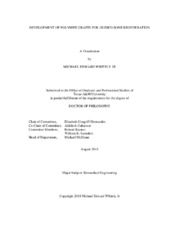| dc.description.abstract | A pressing need exists to develop an improved bone replacement to treat the millions of non-union fractures that occur each year as a result of severe trauma, tumor resection, spinal fusions, and joint replacements. Current bone grafts are often hindered by a lack of biodegradability, porosity or innate ability to promote regeneration. This work employs tissue engineering to design a novel bone replacement that combines the regenerative potential of autologous tissue with the tunability of synthetic grafts. This is accomplished by engineering a biodegradable scaffold with physical and mechanical properties emulating those of cancellous bone and combining this scaffold with technologies that allow for the controlled delivery of stem cells and osteoinductive factors.
In this work, polymerized high internal phase emulsions (polyHIPEs) were developed as an injectable, high porosity bone graft. Thiol-methacrylate polyHIPEs were investigated to increase resistance to oxygen inhibition and improve scaffold function under clinically relevant conditions. Methods were established to modulate and characterize scaffold porosity, cure rate, compressive properties, and degradation rates. Furthermore, cell-laden poly(ethylene glycol)-dithiothreitol hydrogels were developed to improve loading and distribution of human mesenchymal stem cells (hMSCs) within 3D printed polyHIPEs. This approach allowed for increased cell retention and supported critical markers of osteoblastic differentiation. Finally, to confer additional osteoinductive character, porous microspheres with tunable release kinetics and requisite compressive properties were fabricated using a solvent-free, in-line loading approach. Bioactivity retention of encapsulated bone morphogenetic protein-2, along with its ability to promote osteoblastic differentiation of hMSCs, was explored.
Overall, these studies highlight the strong potential of polyHIPE scaffolds to serve as an improved bone replacement with the ability to actively guide bone regeneration. Key technologies have been developed that allow for fabrication of a bone graft with improved function in a clinically relevant setting, efficient seeding with mesenchymal stem cells, and targeted delivery of osteoinductive factors. Fundamentally, this work will be an invaluable tool in identifying and evaluating critical design requirements for future bone graft design. | en |


